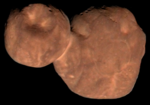 White dwarf WD J0914+1914 and its Neptune-like exoplanet | |
| Observation data Epoch J2000 Equinox J2000 | |
|---|---|
| Constellation | Cancer |
| Right ascension | 09 14 05.30 |
| Declination | +19° 14′ 12.25″ |
| Characteristics | |
| Evolutionary stage | white dwarf |
| Spectral type | DA |
| Astrometry | |
| Radial velocity (Rv) | -47 km/s |
| Proper motion (μ) | RA: −1.221±1.267 mas/yr Dec.: −11.594±1.220 mas/yr |
| Distance | 2038 ly (625 pc) |
| Details | |
| Mass | 0.56 ± 0.03 M☉ |
| Radius | 0.015 R☉ |
| Surface gravity (log g) | 7.85 ± 0.06 cgs |
| Temperature | 27743 ± 310 K |
| Age | 13.3 ± 0.5 Myr |
| Other designations | |
| SDSS J091405.30+191412.2, Gaia DR2 635879254021761024 | |
| Database references | |
| SIMBAD | data |
WD J0914+1914 is the first single white dwarf star found to have a giant planet orbiting it. Evidence of the giant planet was discovered by a team of astronomers from the UK, Chile and Germany.
The system was initially identified as a cataclysmic variable on the basis of weak H-alpha emissions in the spectrum by the Sloan Digital Sky Survey (SDSS). After closer inspection the team of astronomers discovered oxygen and sulfur lines in the SDSS spectra. The team then obtained spectroscopic follow-up observations with X-Shooter on ESO's Very Large Telescope. The spectra confirmed the previous observations by SDSS and found additional lines.
Planets
| Companion (in order from star) |
Mass | Semimajor axis (AU) |
Orbital period (days) |
Eccentricity | Inclination | Radius |
|---|---|---|---|---|---|---|
| b | ~5.07 M🜨 | 0.068 | 8.65 - 10.00 | ~0 | — | ~2.91 R🜨 |
Dusty and gaseous debris disks around white dwarfs are known, but they are dominated by calcium lines and no previous disk around a white dwarf showed Hα emission. All previous disks around white dwarfs originate from rocky planetary bodies. The size of the disk around WD J0914+1914 was measured with the help of Doppler-broadbanded emission lines. The disk around the white dwarf is too large (~1-10 solar radii) to be formed by a small minor planet, which was tidally disrupted inside the Roche Radius. The team was also able to exclude accretion of material from a companion star or brown dwarf.
The most plausible explanation is an evaporating giant planet, orbiting close to the white dwarf. The atmosphere of the planet is evaporated by the strong ultraviolet radiation of the hot white dwarf. The planet is likely to be about 15 solar radii from the white dwarf and orbits it in 10 days. The composition of the accreted material shows similarity to certain deeper layers of the ice giants in the solar system. The team estimated that the planet around WD J0914+1914 will, over the span of about 350 million years, lose about 0.04 Neptune masses, a negligible amount. Meanwhile, the dwarf will continue to cool.
See also
References
- ^ "First Giant Planet around White Dwarf Found – ESO observations indicate the Neptune-like exoplanet is evaporating". www.eso.org. Retrieved 2019-12-11.
- ^ "SDSS J091405.30+191412.2". SIMBAD. Retrieved 2019-12-11.
- Girven, J.; Gansicke, B. T.; Steeghs, D.; Koester, D. (February 2012). "VizieR Online Data Catalog: DA-white dwarfs from SDSS and UKIDSS (Girven+, 2011)". YCat: J/MNRAS/417/1210. Bibcode:2012yCat..74171210G.
- ^ Gänsicke, Boris T.; Schreiber, Matthias R.; Toloza, Odette; Gentile Fusillo, Nicola P.; Koester, Detlev; Manser, Christopher J. "Accretion of a giant planet onto a white dwarf" (PDF). ESO. Retrieved 2019-12-11.
- Gentile Fusillo, N. P.; Gansicke, B. T.; Greiss, S. (May 2015). "VizieR Online Data Catalog: White dwarf candidates in SDSS DR10 (Gentile Fusillo+, 2015)". YCat: J/MNRAS/448/2260. Bibcode:2015yCat..74482260G.
- "First Giant Planet around White Dwarf Found - ESO observations indicate the Neptune-like exoplanet is evaporating".
External links
- https://www.space.com/alien-planet-detected-around-white-dwarf-first-discovery.html
- Gänsicke, Boris T.; Schreiber, Matthias R.; Toloza, Odette; Fusillo, Nicola P. Gentile; Koester, Detlev; Manser, Christopher J. (December 2019). "Accretion of a giant planet onto a white dwarf star". Nature. 576 (7785): 61–64. arXiv:1912.01611. Bibcode:2019Natur.576...61G. doi:10.1038/s41586-019-1789-8. PMID 31802017. S2CID 208617866.
| Constellation of Cancer | |||||||||||
|---|---|---|---|---|---|---|---|---|---|---|---|
| Stars |
| ||||||||||
| |||||||||||
| |||||||||||
| |||||||||||
| Galaxies |
| ||||||||||
| |||||||||||


